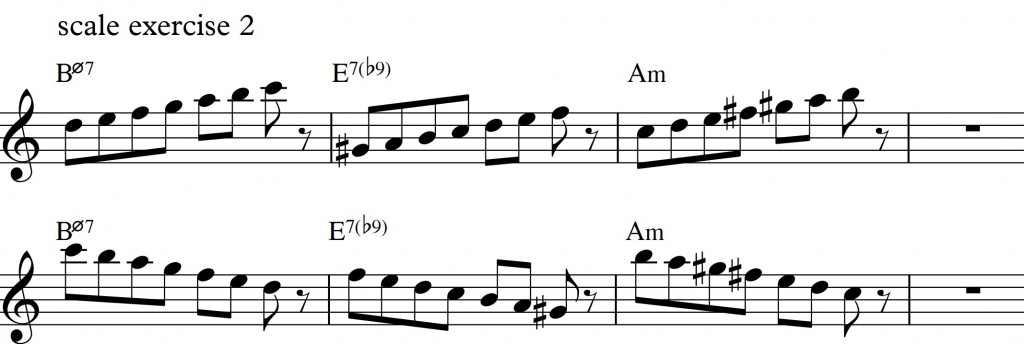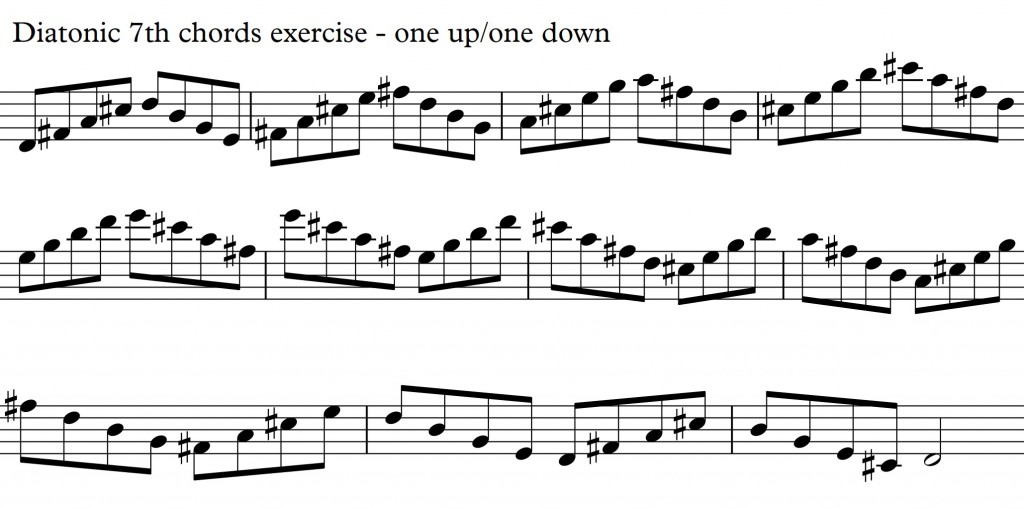In this video I give some exercises and examples in how to improvise over a minor II-V-I using the diatonic 7th chords.
I will focus on the minor II-V-I of Dm – Eø7-A7(b9)-Dm6(maj7).
In this progression ill talk about the 7th chords and how to use these in an improvisation.
The scales that i use are:

On Eø7 i play the F-major scale from the E on: E F G A Bb C D E F – E locrian scale
on the A7(b9) I play the Dm harmonisch toonladder from the A on: A Bb C# D E F G A Bb
i use the scale of Dminor melodic on the Dm6(maj7): D E F G A B C# D E

I play the Eø7 till the 11 – E G Bb D F A
The A7(b9) – A C# E G Bb
Dm6(maj7) D F A C# E
On each chord of the D minor II-V-I i have different 7th chords.
I can find these if i staple 7th chords up from the root/third and/or the fifth.
I start with the Eø7.

I play the Eø7 all the way to the 11 – Eø11 – E G Bb D F A
The following 7th chords can be extracted
Eø7 – E G Bb D
Gm7 – G Bb D F
Bbmaj7 – Bb D F A

On the A7(b9) we find:
on the root: A7 – A C# E G
on the third: C#o – C# E G Bb

The Dm6(maj7)
root Dm6 – D F A B
root Dm(maj7) – D F A C#
third Fmaj7(aug) F A C# E
I played the chords loosly, rubato like without time to be able to listen to the sound of the notes and get the finger combination into my fingers.
Ill get on with an exercise

This exercise is played over the chord progression Eø7 – A7(b9) – Dm6
Playing the 7th-chords going up from the root.
The second line of the exercise i play the 7th-chords from the 7th degree gooing back to the root.
These two ways of playing the chords are something you will often play in a solo and often hear in the solos played by other players.
The next exercise.

I now play the 7th-chords from the third going up and from the 9th, of the original chord, going down. The chords i play here you can see written out simply in the earlier examples here above.
The two last chords when im playing the progression down i play in a different inversion because I liked the sound better of these ones than the ones that matching the rest of the exercise. To work more with this try to play different inversions of the chords and see what you like the best.

This exercise takes you through some of the other chords i presented earlier. the exercise begins on the 5th degree of the Eø11 and then goes on with other possibilities as mentioned above.
In all the exercises above i begin the exercise on the second beat of the bar, just to get used to the sound of this. This will get into your ear and you will eventually also be able to start lines on the second beat the bar in your solo. The rhythm is the most essential of your solo so make sure when you practise that you always have a rhythmical aspect in your exercises. Most people use a lot of time exercising so why not exercise more things in one go!

This exercise works with a continous 8th note line so practising the timing of this and takes you through more arpeggios going up. Root till 7 and 7 till 9 – going up
What i repeat a couple of times in the video, which is also important in your soloing, what goes up can also come down.

Again a continous 8th note line but this one works with the chords decending.

I play the chords acsending from the 3rd to the 9 and from the 9th to the 11th with some minor changes in the chords. Look out!
![]()
The same exercise as above but this time playing the chords descending.
I have made some II-V-I examples by using the above mentioned material, the diatonic 7th chords.
Oc course i also use the scales and approach notes mentioned in earlier videos.
Here is the first example:

I begin by sourrounding the Bb, the 5th of the Eø7, with A and C then running up the Bbmaj7 chord up to the A running down the scale to the D on the A7(b9). The first two beats of the A7(b9) i keep playing the Eø7 resloving to the E of the A7(b9) on beat three, going down the C#o chord of the A7(b9). Resolving to the A of the Dm7 going up an inversion of the Dm6(add9) and on beat three running up the Dm6 ending on the last bar on the D going to the high E surrounding the B with the C# and the A.

I begin this example on the root of th Eø7 going up the scale, surrounding the F with the G and E running down the Gm7 chord, 3rd degree 7th chords of the Eø7. On the A7 i play a standard bebop line A G# G going down to the E, jumoing up to the root arpeggio A7 running up to the Bb in the Dm6 bar staying on the A7(b9) for two beats running down the augmented A triad A F C# to resolve to the 9th of the Dm(maj7) going down the arpeggio E C# A F ending on the second bar of Dm6 descending from the B of the Dm6 to the E.

The first arpeggio in this line is the Gminor triad, see my video on diatonic triads, ending in a standard jazz line playing the maj7 and the minor 7 of the Gminor chord. Jumping down to play the G running up the Gm7 chord over the barline to the A7 resolving to the A7(b9) on beat two ascending the scale of A7 to the C# playing down the C#o arpeggio. Resloving on the Dm to the F going up the Dm6(maj9) chord mixing the B (6), C#(maj7) and the E(9). Ending high on the A going down the chord again and on the last bar of Dm6 i go down the F9aug from the E, down to the F jumping to end on the 6th, B.
I really hope you enjoyed my exercises and examples.
If you want to be directly notified when a new jazz video is online then remember to sign up for my newsletter, just to the right of this text or subscribe to my youtube channel. You can also do both.
Have fun and enjoy the music!










































